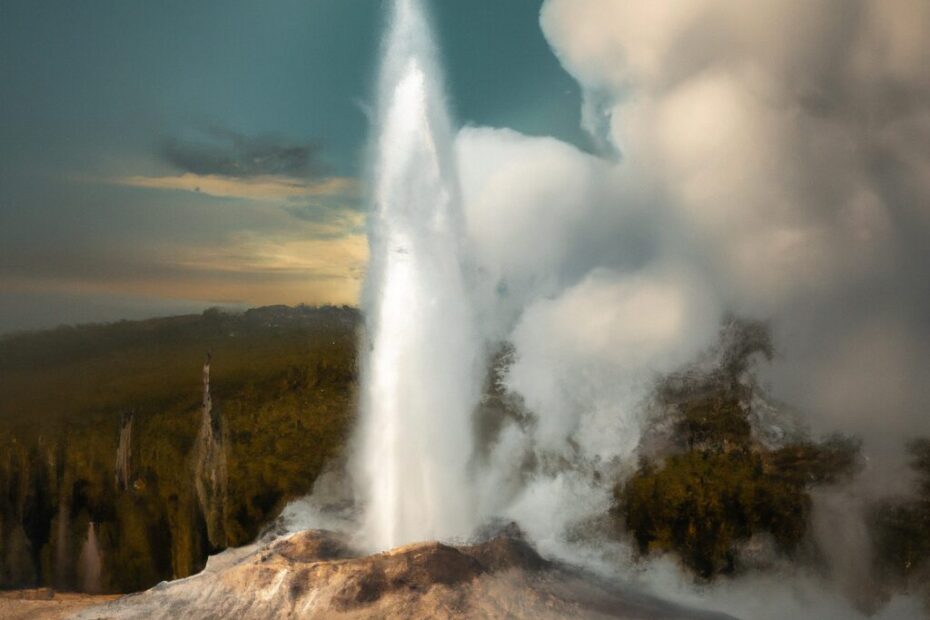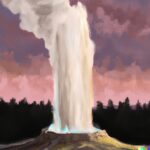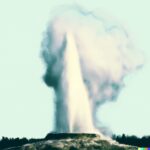If you’ve ever dreamed of witnessing a natural wonder in action, look no further than Old Faithful. This iconic geyser, located in Yellowstone National Park, has captivated visitors for generations with its predictable eruptions. But just how often does Old Faithful erupt? And what factors influence its eruption schedule?
In this article, we’ll explore everything you need to know about Old Faithful’s eruption patterns, including how to predict when the next awe-inspiring display will occur. So sit back, relax, and prepare to be amazed by the wonders of nature.
What is Old Faithful?
Old Faithful is a famous geyser located in Yellowstone National Park, known for its spectacular and predictable eruptions fueled by geothermal activity.
The history of Old Faithful dates back to when it was named by members of the 1870 Washburn Expedition for its consistent eruptions. This iconic geyser has become an emblem of Yellowstone’s geothermal wonders, captivating visitors from around the world.
The geothermal processes that power Old Faithful’s eruptions involve superheated water beneath the Earth’s surface that builds up pressure, eventually bursting through the geyser’s vent in a stunning display of natural power. This cyclic process is a mesmerizing reminder of the delicate balance and sheer force of nature within Yellowstone National Park.
Where is Old Faithful Located?
Old Faithful is situated within the boundaries of Yellowstone National Park, in a remote and geologically active region that attracts visitors from around the world.
Located just a short walk from the park’s Visitor Center, Old Faithful stands as a prominent symbol of nature’s power and beauty. Surrounding this iconic geyser, visitors can witness a mesmerizing display of other geothermal features, such as colorful hot springs and bubbling mud pots. The area near Old Faithful is rich in thermal activity, with steam rising from various vents and pools. It’s a must-see destination that offers an immersive experience into the geothermal wonders of Yellowstone.
What is the Eruption Schedule of Old Faithful?
The eruption schedule of Old Faithful follows a consistent pattern, with timings that can be predicted based on scientific study and monitoring systems.
These regular intervals between Old Faithful’s eruptions are carefully monitored by scientists who analyze various factors such as the duration and height of each eruption, as well as the intervals between successive eruptions. By tracking these patterns over time, researchers can establish a reliable prediction model for Old Faithful’s eruption cycles.
Monitoring instruments like seismographs and thermal sensors play a crucial role in collecting real-time data on the geothermal activity beneath the geyser. This data provides valuable insights into the underlying mechanisms that drive the geyser’s behavior.
How Often Does Old Faithful Erupt?
Old Faithful erupts at regular intervals, providing a mesmerizing display of nature’s power and beauty to visitors at Yellowstone National Park.
The geyser’s eruptions typically occur every 60 to 110 minutes, making it one of the most predictable geysers in the world. This reliability is a result of the underground reservoir filling up with water that eventually reaches a boiling point, leading to the iconic eruptions that shoot water and steam into the air. Park rangers use the timing of previous eruptions to estimate the next one, allowing visitors to witness this natural spectacle with impressive accuracy.
What is the Duration of an Old Faithful Eruption?
An Old Faithful eruption is a spectacular event that typically lasts for a few minutes, captivating spectators with its towering water column and steam display.
The duration of an Old Faithful eruption can vary depending on several factors, such as the amount of water and pressure built up underground. Generally, the eruptions last around 1.5 to 5 minutes, with intervals between eruptions ranging from 60 to 110 minutes. The impressive height of the water column, reaching up to 184 feet, is a result of the geyser’s underground plumbing system and the interaction between hot water and steam. Factors like water temperature, geothermal activity, and underground chambers all play a role in influencing the duration and intensity of these mesmerizing eruptions.
What is the Height of an Old Faithful Eruption?
During an eruption, Old Faithful propels a water column to significant heights, creating a mesmerizing spout that showcases the geyser’s power and geothermal energy.
The water column reaches impressive heights, sometimes soaring as high as 180 feet in the air. As the powerful jets of water shoot up into the sky, they form intricate patterns before cascading back down in a spectacular display. This natural phenomenon captivates onlookers, drawing them in with its raw energy and beauty. The sheer force and intensity of the eruption leave spectators in awe, making them appreciate the sheer power of nature unleashed by Old Faithful.
What Factors Affect the Eruption Schedule of Old Faithful?
- Several factors influence the eruption schedule of Old Faithful, including the geyser’s geothermal features, the underlying geology, and the ongoing geological activity in the region.
The geologic processes play a crucial role in dictating when Old Faithful will erupt. The geyser’s eruptions are fueled by the immense heat generated by geothermal energy beneath the Earth’s surface. This energy source interacts with the geological formations in the area, creating the perfect conditions for the hydrothermal system within the geyser. As water seeps deep into the earth, it is heated by magma chambers and rises back to the surface, building up pressure until it eventually bursts forth in a magnificent display of natural power.
What is the Role of Geysers in Old Faithful’s Eruption?
Geysers in Yellowstone, including Old Faithful, play a crucial role in releasing geothermal energy from the supervolcano beneath the park, showcasing the dynamic forces of nature at work.
As underground water seeps down through fractures in the Earth’s crust and comes into contact with the superheated magma chambers of the supervolcano, it gets heated to extreme temperatures. This heated water eventually builds up pressure deep underground.
When the pressure becomes too great, the water is forcefully expelled upwards through narrow vents, creating the iconic eruptions that we witness at geysers like Old Faithful. The explosive release of this pent-up pressure and heat from deep within the Earth is a mesmerizing display of the power of geothermal energy harnessed by nature.
How Does the Weather Affect Old Faithful’s Eruption Schedule?
Weather conditions can impact Old Faithful’s eruption schedule, with factors like temperature and atmospheric pressure playing a role in the timing and intensity of the geyser’s eruptions.
The frequency and duration of eruptions from geysers like Old Faithful are closely linked to shifts in weather patterns and larger climate trends. As temperatures rise due to climate change, there is a potential for alterations in the behavior of geysers as well. Changes in precipitation levels and humidity can also influence the underground water reservoirs that feed these geysers, affecting their eruption patterns.
Understanding these environmental factors is crucial in monitoring and predicting the activity of iconic geysers in Yellowstone National Park and beyond.
Are There Any Human Factors That Can Influence Old Faithful’s Eruption?
Human activities, such as visitor information dissemination and park ranger monitoring, can aid in forecasting Old Faithful’s eruptions and ensuring the safety of tourists in the area.
Visitors are often intrigued by the predictable nature of Old Faithful’s eruptions and eagerly await its spectacular display. Park rangers play a pivotal role in overseeing visitor management and geothermal safety measures, ensuring that tourists maintain a safe distance from the geyser to prevent any mishaps. Visitor information centers disseminate crucial details about eruption timings, allowing visitors to plan their visits accordingly. The collaboration between park rangers, scientific researchers, and eruption forecasting methods enhances the overall visitor experience while prioritizing safety in the geothermal wonderland.
Why is Old Faithful’s Eruption Schedule Important?
Understanding and monitoring Old Faithful’s eruption schedule is crucial for managing geologic hazards, conserving natural resources, and leveraging geothermal economics in the region.
By closely tracking the eruptions of Old Faithful, researchers and authorities can gain valuable insights into the underlying geological processes that contribute to the geyser’s activity. This data not only helps in predicting potential geologic risks but also paves the way for sustainable resource management practices. Harnessing the geothermal energy potential of the region presents lucrative economic opportunities, promoting innovation and investment in renewable energy sources. This integration of scientific monitoring with economic development showcases the interconnectedness of conservation efforts and sustainable utilization of natural resources.
How Can You Predict an Old Faithful Eruption?
Predicting an Old Faithful eruption involves observing specific signs, utilizing eruption forecasting techniques, and monitoring seismic activity to anticipate the geyser’s next spectacular event.
Seismic data analysis plays a crucial role in understanding the underground activity of the geyser. By monitoring seismic waves, scientists can detect movement and changes in pressure beneath the surface, providing valuable insights into the build-up of pressure that leads to an eruption. Observational signs such as increased water temperature, steam emissions, and fluctuations in the height and interval between eruptions are key indicators that inform the forecasting process. Integration of various eruption forecasting tools, including statistical models and geologic monitoring instruments, further enhances the accuracy of predicting Old Faithful’s eruptions.
What Are the Signs That an Old Faithful Eruption is About to Occur?
Various signs, including changes in the geyser’s behavior and data from monitoring systems, can indicate that an Old Faithful eruption is imminent, following established patterns observed over time.
Prior to an eruption, visitors and park rangers may notice increased water levels in the geyser’s vent, along with heightened activity such as frequent spouting or rumbling. Monitoring systems play a crucial role in tracking these fluctuations, utilizing data on water temperature, geyser height, and intervals between eruptions. By analyzing these indicators, geologists can make informed predictions about when the next eruption is likely to occur, helping to ensure visitor safety and providing invaluable insights into the fascinating behavior of this iconic natural wonder.
Are There Any Tools or Apps to Help Predict Old Faithful’s Eruptions?
Specialized monitoring systems and seismograph data are utilized in geothermal exploration to develop tools and apps that aid in predicting Old Faithful’s eruptions, enhancing the visitor experience and scientific understanding of geyser activity.
These technological advancements have revolutionized the way researchers and geologists observe volcanic behavior, leading to more accurate prediction models for volcanic eruptions. With the integration of advanced sensors and data analysis techniques, scientists can now detect subtle changes in temperature and pressure beneath the Earth’s surface, allowing for early warnings of potential geological hazards.
The development of user-friendly apps also enables park visitors to track the geothermal activity of Old Faithful in real-time, providing an interactive and informative experience that combines education and entertainment.
Last Updated on February 11, 2024 by Jon Waraas – Originally Posted: February 11, 2024

I’m Jon Waraas, and I’ve been navigating the online world since 2006. By day, I’m the proud owner of some eCommerce gems, and by night, I’m the voice behind the adventures on Waraas.Com.
My heart, however, belongs to the wild beauty of Yellowstone National Park. I’ve got a collection of websites dedicated to sharing the wonders of this natural masterpiece. Oh, and did I mention? I’m currently building my own cabin inside the ghost town of Gilmore, Idaho – a cabin with tales to tell!
When I’m not immersed in the digital realm, you’ll find me lacing up my boots for a good hike or setting up camp under the star-studded sky.




